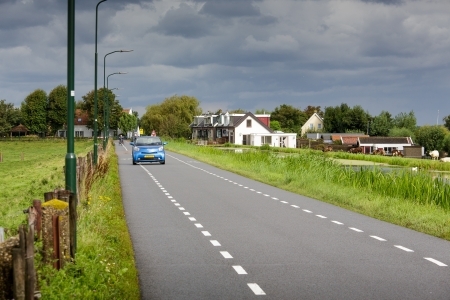Cyclists may use solitary bicycle/moped tracks, access roads and distributor roads, and intersections between these road types. Safety principles for bicycle tracks, road sections and intersections are presented below. For more information on the design of bicycle facilities, see the Ontwerpwijzer Fietsverkeer (Design Guide for Bicycle Traffic) [10] and the updated recommendations for bicycle track widths and guidelines for markings on bicycle tracks [11] [12]. For more information on facilities for cyclists, see also SWOV fact sheet Infrastructure for pedestrians and cyclists.
Safety principles have also been defined at the route level. In 2022, SWOV proposed seven features for bicycle route safety [13]. These features are aimed at minimising exposure to road unsafety and avoiding conflicts with motorised traffic.
Bicycle tracks
Kennisnetwerk SPV (Knowledge network SPV) has drawn up risk indicators for safe bicycle tracks. These include the following design principles [14]:
- no obstacles;
- good visual guidance, for example by means of edge markings;
- sufficient width;
- pavement is flat, skid-resistant, whole and clean;
- forgiving edge;
- forgiving roadside.
Road sections
On the road sections of distributor roads, motorised traffic travels at high speeds and should be able to flow. Road safety requires physical separation between motorised traffic and cyclists by means of separate bicycle tracks. In the construction of bicycle facilities along road sections, it is important to ensure that no conflicts may arise between parking vehicles (manoeuvres, car doors being opened and disembarking passengers) and passing cyclists.
Intersections
At intersections, cyclists mix with car traffic, and travel speeds of motorised traffic should therefore be lower than on the connecting road sections. When roundabouts have been applied, the speeds driven are automatically quite low (see SWOV fact sheet Roundabouts and other intersections). At other types of intersections, a lower speed may be enforced by speed-reducing measures such as speed humps just before the intersection or a raised intersection (plateau). In addition, it is safer if the bicycle crossing at the intersection is deflected 2 to 5 meters from the carriageway, which is also referred to as "deflecting" the bicycle track [15] [16] [17] [18]. On busy roads, a median allows cyclists to cross the road more safely. At intersections, relatively more crashes occur on two-way bicycle tracks than on one-way bicycle tracks [19].
At intersections where large groups of cyclists want to turn left, cyclists often have to wait twice, which encourages red light negation. To reduce this, measures such as push buttons with a waiting signal, waiting time predictors (if properly applied) and four-way green can be applied [20].
